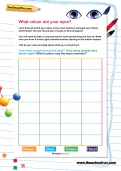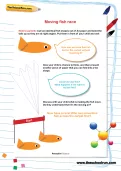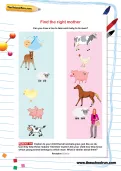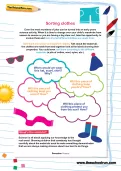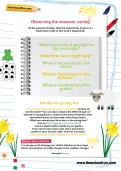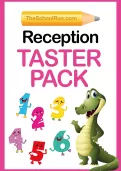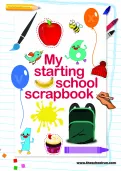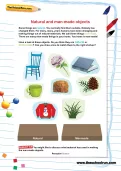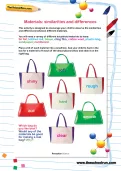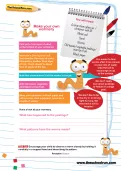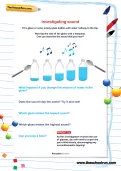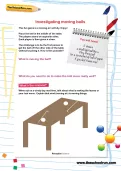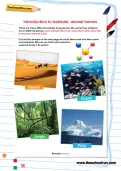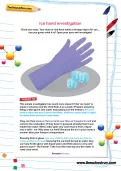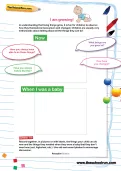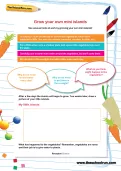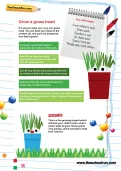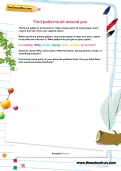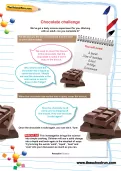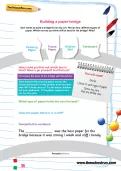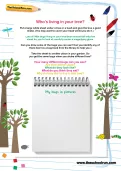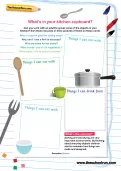Find out what your child will learn in Reception English, maths and science, try out a few learning activities and read our top tips about how to support their learning and development in our free, downloadable Reception Taster Pack.
or
Register to add to your saved resources
If your child is starting school in Reception, what can you do to help them make the best possible start? Find out how to lay the foundations for a great transition with our Reception starters learning pack – it's bursting with activities that focus on early English, maths and science skills, as well as supporting your child's physical and social development.
or
Register to add to your saved resources
Already a subscriber? to view this content.
Let’s find out which eye colour is the most common amongst your family and friends! You can record your results on this pictogram.
or
Register to add to your saved resources
Have a look at these objects. Do you think they are natural or man-made? Can you draw a line to match them to the right shelves?
or
Register to add to your saved resources
Already a subscriber? to view this content.
Can you move this fish across the carpet without touching it? Let's have a race...
or
Register to add to your saved resources
This activity is designed to encourage your child to observe the similarities and differences between different materials.
or
Register to add to your saved resources
Already a subscriber? to view this content.
Fancy some pet worms? Discover the amazing life of worms by making your own wormery.
or
Register to add to your saved resources
Fill a glass or some empty glass bottles with water halfway to the top. Now tap the side of the glass with a teaspoon. Can you describe the sound that you hear?
or
Register to add to your saved resources
Already a subscriber? to view this content.
Let's explore how air moves by playing a fun game!
or
Register to add to your saved resources
Already a subscriber? to view this content.
There are many different animals living all over the world.They all like to live in different places; some animals like it hot, some like it cold, some like it wet and some like it dry. Cut out the animals on the next page and stick them back into their home environments. Why do you think each animal is suited to living in its home?
or
Register to add to your saved resources
Already a subscriber? to view this content.
Close your eyes. Your mum or dad have made a strange object for you... can you guess what it is? Open your eyes and investigate!
or
Register to add to your saved resources
Already a subscriber? to view this content.
In understanding that living things grow, it is fun for children to observe how they themselves have grown and changed. Children are usually very enthusiastic about talking about all the things they can do!
or
Register to add to your saved resources
Already a subscriber? to view this content.
How would you like to have your own little island? Let's find out how...
or
Register to add to your saved resources
Already a subscriber? to view this content.
It’s easy to make your very own grass head. You can keep your head on the window sill, and you’ll be amazed at how fast it grows!
or
Register to add to your saved resources
Already a subscriber? to view this content.
Can you draw a line to take each baby to its mum?
or
Register to add to your saved resources
There are patterns all around us. Take a large piece of white paper and a crayon and see if you can capture some!
or
Register to add to your saved resources
Already a subscriber? to view this content.
Here's a tasty science experiment for you, investigating solids and liquids!
or
Register to add to your saved resources
Already a subscriber? to view this content.
Sam wants to build a bridge for his toy car. He has four different types of paper. How could you find out which one is best? Have a go yourself and find out!
or
Register to add to your saved resources
Already a subscriber? to view this content.
Put a large white sheet under a tree or a bush and give the tree a good shake. Lots of little bugs living in your tree/bush should fall onto the sheet for you to look at carefully under a magnifying glass. Can you draw some of the bugs you can see? Can you identify any of them?
or
Register to add to your saved resources
Can you work with an adult to group some of the objects in your kitchen? Sort them into piles or draw pictures of them on these cards
or
Register to add to your saved resources
Already a subscriber? to view this content.
